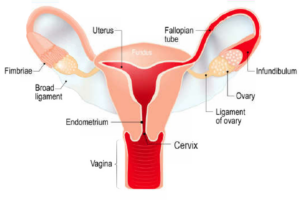There appears to be a huge amount of misunderstanding regarding a hysterectomy, and therefore this article will attempt to make the operation of laparoscopic hysterectomy easier to understand by exploring the common myths.
There are 32,000 hysterectomies performed in Australia each year. The majority are for heavy menstrual bleeding, but other indications might include prolapse, endometriosis, cancer, or fibroids.
Most surgeries nowadays are performed laparoscopically through 3 x 5 mm incisions in the abdomen.
By Dr Graeme Walker, Gynaecologist & Colposcopist. Founder of the Menstrual Misery Clinic.


Myth 1
Will the hysterectomy cause instantaneous menopause with all its devastating side effects?
The answer is no. In the majority of cases we only take the womb, cervix and tubes, the ovaries are left behind, which has no immediate effect on hormones and therefore does not result in any menopausal symptoms at all. There are a few rare cases when the ovaries are removed, but this is because the patient has ovarian or endometrial cancer or for other specific genetic reasons. For 95% of the general female population, the ovaries are not removed.
Myth 2
Will I still get a period after a hysterectomy?
I am pleased to say that although patients may experience spotting for up to 6 weeks post-surgery, patients will never have a period again, which is excellent news for women in general, but more so for those women requiring multiple iron infusions due to heavy periods.
Myth 3
After a hysterectomy, is there a hole created in the pelvis?
The uterus is usually quite small, certainly less than 10 cm in diameter, and the space created by removing it is filled almost instantly with the small bowel, which quite happily fills the very small space generated by a hysterectomy
Myth 4
Does the cervix have to be removed?
No, it can remain. However, there is no difference in prolapse, sexual function, urinary incontinence, or complications if we leave or remove the cervix, but if left behind, it may lead to annoying spotting, and you will have to continue to attend for pap smears.
Myth 5
A hysterectomy results in a long and difficult, restricted recovery:
This is absolutely not the case. Most people go home either on the day of surgery or the following day. In my private practice, I review all of my patients seven days post-op, and interestingly, for the majority, you cannot tell that they had surgery a week ago.
There are however, certain rules to follow post-operatively, as there are for any surgery, and these include no swimming, taking baths, or going to the gym for up to4 weeks, although showers are perfectly fine. In addition, no sex for 8 weeks.
Myth 6
For those patients who have HPV identified during a pap smear, a hysterectomy will get rid of it:
Absolutely not. The virus can live in the cervix or the vagina. Getting rid of the cervix via a hysterectomy will remove the cervix but not the virus. You will still require a pap smear of the vagina, potentially for several years. Patients who are HPV negative at the time of hysterectomy and are on a 5-year recall will never require another pap smear though!
Myth 7
Hysterectomy is the only treatment for heavy periods:
False. There are many other treatment options for heavy periods, and these include fairly basic options such as the contraceptive pill, Mirena, endometrial ablation, Ukraine Artery embolization and, in some cases, a drug called Zoladex. However, there are a certain number of patients who have tried a selection of the above options to no avail. When they comment during the consultation, “I am over it,” you know that the patient has reached the end of their tether and is essentially requesting a hysterectomy in the knowledge that post-procedure, these patients will join a growing band of women who state that “hysterectomy is the best thing that they have ever done.”
Myth 8
A hysterectomy will result in a prolapse:
There are mixed results in the published literature, and the conclusion really is that prolapse is likely to be multifactorial and increased by multiple factors, including the presence of pre-existing prolapse, age, menopausal status, surgical technique, and the number of pregnancies. In my experience, prolapse following a hysterectomy is not at all common.
Myth 9
Sex will be worse following a hysterectomy:
Again, no definitive conclusion is reported, but most women seem to report improved or better sexual function after a hysterectomy, perhaps because those who suffer from chronic pelvic pain or discomfort from other conditions such as endometriosis or fibroids have that source of pain removed, therefore enhancing overall sexual wellbeing. For those women with profound, uncontrolled, heavy irregular periods, there are obvious benefits to having no uterus!
Myth 10
A hysterectomy is a risky surgical procedure:
Thankfully not. Like any surgical procedure, there are risks, but serious ones are rare. Most commonly, there are superficial wound infections, maybe a UTI or constipation. Risks such as bleeding, damage to the bowel or bladder or clots in the leg are minimised due to advances in laparoscopic surgical techniques and improvements in theatre efficiency and vast improvement in the clarity of laparoscopic vision.
If you have any questions, please contact our team at [email protected]
Dr Walker has performed well over 1000 laparoscopic hysterectomies with a highly selective dedicated team performing each operation resulting in exceptional efficiency and minimal complications.
He is the only surgeon in Australia that routinely allows patients to go home on the same day of surgery if that is the wish of the patient. 250 patients have chosen that wish of day case hysterectomies as their first choice, with the patient’s journey being published in the peer-reviewed RANZCOG journal.







